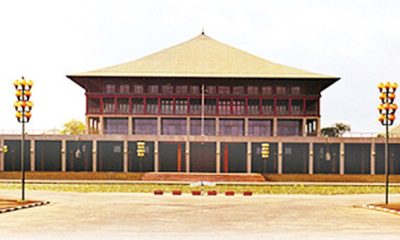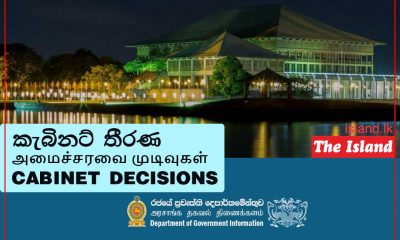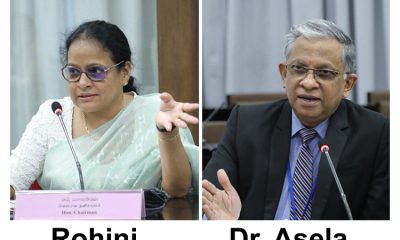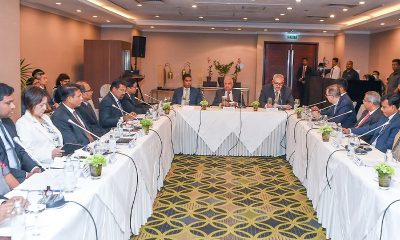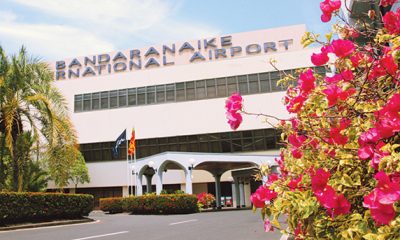Features
AKD’s NPP-JVP & the Generic Left Aren’t Doing Their Best to Win
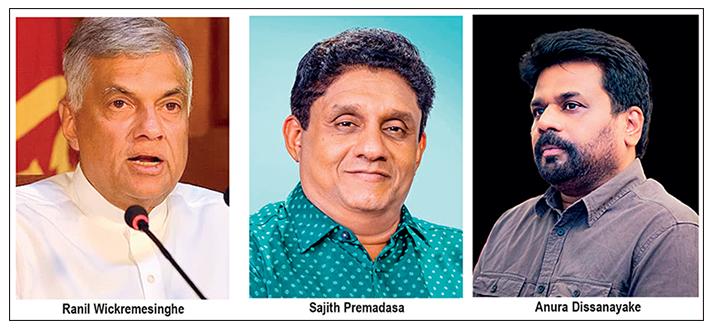
Dr Dayan Jayatilleka
The Left has the best chance of being elected to office in Sri Lanka since 1964 or 1947. That’s speculative. So let me put it more clearly. Never in my lifetime has the Left been closer to assuming governmental power by democratic means, i.e., leading the country. We have never been closer to having a left-wing leader and administration.
Society is dividing between those who think that’s a good thing and those who think it’s bad. As Mao said in his first political essay on the Peasant Movement in Hunan, opinion is divided between those who say “it’s fine” and those who say “it’s terrible”. Mao thought it was fine.
We had a similar division of opinion during the Aragalaya. Opinion remains divided about it. I was among those who said “it’s fine”. Ranil thought it was fine and then that it was terrible. The Pohottuwa thought it was terrible all along.
This was a throwback to the division of opinion in Ceylon about the Hartal of August 1953, the popular uprising that left eight dead of Police shooting and a Prime Minister who resigned. Progressive-minded people, like my father, at the time a reporter for Lake House just out of university, were in sympathy with and admiring of the Hartal. His father, a staunch UNPer, thought it was terrible. Those who sympathized with the Hartal ’53 went on to applaud the crushing defeat of the UNP by SWRD Bandaranaike in 1956.
Why I Welcome AKD-JVP-NPP
Those who supported the Aragalaya would tend to support the Anura Dissanayake candidacy and the JVP-NPP, but with an interesting difference. A splinter supports Ranil Wickremesinghe, Sir John Kotelawala’s political descendent. True, those who endorsed the Hartal were also divided between the Marxist Left and the center-left SLFP, but no one supported Sir John Kotelawala, Ranil’s political ancestor.
I supported the Aragalaya as my published writing shows. I also welcome and support the rise of the Left in the form of the JVP-NPP led by Anura Dissanayake. I do this despite being prominently on the other side of Wijeweera’s JVP during the left-on-left mini-civil war of the 1980s. The issues which divided us then no longer exist or do not divide us anymore.
There’s another reason that I welcome the AKD-JVP-NPP option this year. My intellectual formation having been Marxist, I have always regarded myself as on the Left. When this article appears, the top international policy journal in Moscow, namely Russia in Global Affairs, would be featuring an essay by me on Lenin’s relevance today, marking his death centenary.
However, since 1984-5 when I wrote four cover stories in the Lanka Guardian supporting Vijaya Kumaratunga and his new party, I have been a leftist committed to Social Democracy and have preferred to support the closest available approximation to it, which chiefly meant progressive-populists (Vijaya, Premadasa, Mahinda) rather than Marxist-Leninists.
Today, the candidacy and the party I thought would fill that slot, Sajith Premadasa and the SJB, do not do so and have abandoned the progressive-centrist space. Unlike as presidential candidate in November 2019 and through to mid-late 2022, Sajith is objectively functioning today as a mask for economic (neoliberal) Harsha Chinthanaya which is itself a mask for economic (neoliberal) Ranil Chinthanaya.
Harsha’s current claim to fame being his World bank credentials (he says ‘advisor’ in Sinhala, but could mean ‘consultant’ or participant in World Bank projects—in Nepal and Bhutan) is amusing. If those credentials were so decisively valuable, then why did Ranil and his economic team including Dr Harsha de Silva totally ignore the advice given in Colombo in 2015 by no less than the former Chief Economist of the World Bank and Nobel Prize-winner for economics, Joseph Stiglitz? And why isn’t he critical of it even in retrospect? Why doesn’t he embrace Stiglitz’ advice even today, but prefer Ricardo Hausmann instead?
In the absence of a progressive-centrist alternative, and with the populist-developmentalist or populist-centrist formation turning right, embracing neoliberal austerity, my foundational leftism provides the compass which points me to that Left—the clearly main party of the Left– which has built a political mass movement of a left-populist character.
However, and completely unrelated to the 1980s, my support of the AKD-NPP-JVP formation is not uncritical. What I am critical about is that they are not doing all they can or should – because this may be all they can—to win this historic victory.
I am critical, though supportive, not only of the JVP-NPP, but also of the Left in general. That’s because the ‘generic Left’ is not doing all it can to help secure this historic victory.
Left Gaps and Deficits
I note the following gaps and deficits, which if not bridged could cost AKD and the NPP-JVP either the presidential or parliamentary election or both. Bridging these gaps in time could secure victory.
The cold war or unbridgeable distance between the JVP-NPP and the FSP-JAV (Frontline Socialst Party – Jana Araala Vyaparaya).
The lack of activity by the left intellectuals and academics of both the pro-NPP-JVP camp and the non-NPP-JVP camp.
The lack of outreach of the non-JVP-NPP Left in the direction of the JVP-NPP.
The lack of outreach of the JVP-NPP to other left and progressive elements.
Firstly, the gap between the JVP-NPP and the FSP-JAV. Let’s be frank. Anura Kumara is concerned that the FSP’s radicalism could scare off middle-class voters. There’s no point debating that. What must be recognized is that each party needs the other, and though the FSP is far smaller, the JVP has more to lose.
What the FSP could bring to the table is the power of public persuasion wielded so modestly by the JVP’s former educational Secretary and currently the FSP’s Educational Secretary, Pubudu Jayagoda. No one mounts a better economic critique than he does. Jayagoda is the country’s most successful public pedagogue and model of what Antonio Gramsci called an organic intellectual.
The JVP and FSP must be creative and flexible enough to work out an understanding whereby the FSP-JAV opens an autonomous, parallel ‘second front’, waging a politico-ideological ‘guerrilla war’ of resistance against the common neoliberal enemy. One possibility would be cooperation NOT between the JVP and FSP but between their respective social movements or political mass movements.
Secondly, the strange silence of the left academia and intelligentsia, both ‘pro’ and ‘non’ NPP-JVP. In pre-election 1970 the universities were ‘ideas factories’ for the oppositional United Front coalition. I know because my uncle (my father’s brother-in-law) Prof PEE Fernando, was in the forefront at Peradeniya. OK, so there’s no united front today, but there are academics sympathetic to the NPP as to the FSP-JAV.
For the NPP this is election year. For the FSP-JAV, which isn’t that into elections, there’s the biggest threat of a neoliberal shock therapy agenda in Sri Lanka’s history. However, there’s far more activity and a higher profile of the economic neoliberals who are waging an ideological offensive to ensure that whatever the electoral outcome, the neoliberal model and agenda are adhered to, than there is of the collective left intelligentsia—with the academia at its core.
The latter should be waging a battle the ideas, the battle for moral-ethical, intellectual-cultural and ideological hegemony, without which there can be no sustainable political victory.
Thirdly, the non-JVP Left parties have limited options, none of which they are activating. They can reach out to the JVP-NPP and arrive at some arrangement which entails a division of labour in what must be recognized as a decisive common battle. Or they can become part of a parallel ‘second front’ with the FSP-JAV-IUSF (Inter University Students Federation). Or they can form a solid front with the Dullas faction of the FPC (Dullas’ Freedom People’s Congress), which in no way contradicts the earlier mentioned option of a second front. If they do none of these, they will be discredited by company of the social chauvinist dominated Uttara Lanka and wiped out electorally.
Fourthly and finally is the JVP-NPP’s insistence that in a repetition of the ‘Walk of Shame’ in the Game of Thrones, penitents may enter the NPP as individuals, but parties or factions will not be accommodated in a bloc.
Why Risk Defeat?
In a tribute to Lenin on his death centenary, I could of course quote Lenin on the united front, from the proceedings of the second and third Congresses of the Communist International (Comintern) in 1920 and 1921, but I won’t. Instead, I’ll stick to the hard historical facts of elections on this island.
Except for the first two occasions, every time a party won, it was as a coalition. Those two exceptions were DS Senanayake in 1947 and Dudley Senanayake in 1952. DS immediately formed a multi-party, multiethnic coalition government. Dudley’s UNP didn’t, and he was overthrown in one year by the Hartal 1953, and the UNP swept away in 1956.
Every government was formed after an election (barring 1952) was as a coalition.
Every single time a government was defeated in the island’s historical victory, it was by an Opposition coalition. That includes the JR-led landslide of 1977. The UNP had one powerful ally, a trade union plus political party, the Ceylon Workers Congress (CWC) led by the iconic S. Thondaman.
That indicates something about the complex terrain of the Sri Lankan social formation and therefore its politics.
The JVP-NPP is trying to go it alone. Again. Why does it want to run the risk of bucking those odds, when it can easily form a political coalition of the left, progressive and democratic parties and organizations under its leadership and around, i.e., in support of, Anura Kumara Dissanayake’s presidential candidacy?
Features
The heart-friendly health minister

by Dr Gotabhya Ranasinghe
Senior Consultant Cardiologist
National Hospital Sri Lanka
When we sought a meeting with Hon Dr. Ramesh Pathirana, Minister of Health, he graciously cleared his busy schedule to accommodate us. Renowned for his attentive listening and deep understanding, Minister Pathirana is dedicated to advancing the health sector. His openness and transparency exemplify the qualities of an exemplary politician and minister.
Dr. Palitha Mahipala, the current Health Secretary, demonstrates both commendable enthusiasm and unwavering support. This combination of attributes makes him a highly compatible colleague for the esteemed Minister of Health.
Our discussion centered on a project that has been in the works for the past 30 years, one that no other minister had managed to advance.
Minister Pathirana, however, recognized the project’s significance and its potential to revolutionize care for heart patients.
The project involves the construction of a state-of-the-art facility at the premises of the National Hospital Colombo. The project’s location within the premises of the National Hospital underscores its importance and relevance to the healthcare infrastructure of the nation.
This facility will include a cardiology building and a tertiary care center, equipped with the latest technology to handle and treat all types of heart-related conditions and surgeries.
Securing funding was a major milestone for this initiative. Minister Pathirana successfully obtained approval for a $40 billion loan from the Asian Development Bank. With the funding in place, the foundation stone is scheduled to be laid in September this year, and construction will begin in January 2025.
This project guarantees a consistent and uninterrupted supply of stents and related medications for heart patients. As a result, patients will have timely access to essential medical supplies during their treatment and recovery. By securing these critical resources, the project aims to enhance patient outcomes, minimize treatment delays, and maintain the highest standards of cardiac care.
Upon its fruition, this monumental building will serve as a beacon of hope and healing, symbolizing the unwavering dedication to improving patient outcomes and fostering a healthier society.We anticipate a future marked by significant progress and positive outcomes in Sri Lanka’s cardiovascular treatment landscape within the foreseeable timeframe.
Features
A LOVING TRIBUTE TO JESUIT FR. ALOYSIUS PIERIS ON HIS 90th BIRTHDAY

by Fr. Emmanuel Fernando, OMI
Jesuit Fr. Aloysius Pieris (affectionately called Fr. Aloy) celebrated his 90th birthday on April 9, 2024 and I, as the editor of our Oblate Journal, THE MISSIONARY OBLATE had gone to press by that time. Immediately I decided to publish an article, appreciating the untiring selfless services he continues to offer for inter-Faith dialogue, the renewal of the Catholic Church, his concern for the poor and the suffering Sri Lankan masses and to me, the present writer.
It was in 1988, when I was appointed Director of the Oblate Scholastics at Ampitiya by the then Oblate Provincial Fr. Anselm Silva, that I came to know Fr. Aloy more closely. Knowing well his expertise in matters spiritual, theological, Indological and pastoral, and with the collaborative spirit of my companion-formators, our Oblate Scholastics were sent to Tulana, the Research and Encounter Centre, Kelaniya, of which he is the Founder-Director, for ‘exposure-programmes’ on matters spiritual, biblical, theological and pastoral. Some of these dimensions according to my view and that of my companion-formators, were not available at the National Seminary, Ampitiya.
Ever since that time, our Oblate formators/ accompaniers at the Oblate Scholasticate, Ampitiya , have continued to send our Oblate Scholastics to Tulana Centre for deepening their insights and convictions regarding matters needed to serve the people in today’s context. Fr. Aloy also had tried very enthusiastically with the Oblate team headed by Frs. Oswald Firth and Clement Waidyasekara to begin a Theologate, directed by the Religious Congregations in Sri Lanka, for the contextual formation/ accompaniment of their members. It should very well be a desired goal of the Leaders / Provincials of the Religious Congregations.
Besides being a formator/accompanier at the Oblate Scholasticate, I was entrusted also with the task of editing and publishing our Oblate journal, ‘The Missionary Oblate’. To maintain the quality of the journal I continue to depend on Fr. Aloy for his thought-provoking and stimulating articles on Biblical Spirituality, Biblical Theology and Ecclesiology. I am very grateful to him for his generous assistance. Of late, his writings on renewal of the Church, initiated by Pope St. John XX111 and continued by Pope Francis through the Synodal path, published in our Oblate journal, enable our readers to focus their attention also on the needed renewal in the Catholic Church in Sri Lanka. Fr. Aloy appreciated very much the Synodal path adopted by the Jesuit Pope Francis for the renewal of the Church, rooted very much on prayerful discernment. In my Religious and presbyteral life, Fr.Aloy continues to be my spiritual animator / guide and ongoing formator / acccompanier.
Fr. Aloysius Pieris, BA Hons (Lond), LPh (SHC, India), STL (PFT, Naples), PhD (SLU/VC), ThD (Tilburg), D.Ltt (KU), has been one of the eminent Asian theologians well recognized internationally and one who has lectured and held visiting chairs in many universities both in the West and in the East. Many members of Religious Congregations from Asian countries have benefited from his lectures and guidance in the East Asian Pastoral Institute (EAPI) in Manila, Philippines. He had been a Theologian consulted by the Federation of Asian Bishops’ Conferences for many years. During his professorship at the Gregorian University in Rome, he was called to be a member of a special group of advisers on other religions consulted by Pope Paul VI.
Fr. Aloy is the author of more than 30 books and well over 500 Research Papers. Some of his books and articles have been translated and published in several countries. Among those books, one can find the following: 1) The Genesis of an Asian Theology of Liberation (An Autobiographical Excursus on the Art of Theologising in Asia, 2) An Asian Theology of Liberation, 3) Providential Timeliness of Vatican 11 (a long-overdue halt to a scandalous millennium, 4) Give Vatican 11 a chance, 5) Leadership in the Church, 6) Relishing our faith in working for justice (Themes for study and discussion), 7) A Message meant mainly, not exclusively for Jesuits (Background information necessary for helping Francis renew the Church), 8) Lent in Lanka (Reflections and Resolutions, 9) Love meets wisdom (A Christian Experience of Buddhism, 10) Fire and Water 11) God’s Reign for God’s poor, 12) Our Unhiddden Agenda (How we Jesuits work, pray and form our men). He is also the Editor of two journals, Vagdevi, Journal of Religious Reflection and Dialogue, New Series.
Fr. Aloy has a BA in Pali and Sanskrit from the University of London and a Ph.D in Buddhist Philosophy from the University of Sri Lankan, Vidyodaya Campus. On Nov. 23, 2019, he was awarded the prestigious honorary Doctorate of Literature (D.Litt) by the Chancellor of the University of Kelaniya, the Most Venerable Welamitiyawe Dharmakirthi Sri Kusala Dhamma Thera.
Fr. Aloy continues to be a promoter of Gospel values and virtues. Justice as a constitutive dimension of love and social concern for the downtrodden masses are very much noted in his life and work. He had very much appreciated the commitment of the late Fr. Joseph (Joe) Fernando, the National Director of the Social and Economic Centre (SEDEC) for the poor.
In Sri Lanka, a few religious Congregations – the Good Shepherd Sisters, the Christian Brothers, the Marist Brothers and the Oblates – have invited him to animate their members especially during their Provincial Congresses, Chapters and International Conferences. The mainline Christian Churches also have sought his advice and followed his seminars. I, for one, regret very much, that the Sri Lankan authorities of the Catholic Church –today’s Hierarchy—- have not sought Fr.
Aloy’s expertise for the renewal of the Catholic Church in Sri Lanka and thus have not benefited from the immense store of wisdom and insight that he can offer to our local Church while the Sri Lankan bishops who governed the Catholic church in the immediate aftermath of the Second Vatican Council (Edmund Fernando OMI, Anthony de Saram, Leo Nanayakkara OSB, Frank Marcus Fernando, Paul Perera,) visited him and consulted him on many matters. Among the Tamil Bishops, Bishop Rayappu Joseph was keeping close contact with him and Bishop J. Deogupillai hosted him and his team visiting him after the horrible Black July massacre of Tamils.
Features
A fairy tale, success or debacle

Sri Lanka-Singapore Free Trade Agreement
By Gomi Senadhira
senadhiragomi@gmail.com
“You might tell fairy tales, but the progress of a country cannot be achieved through such narratives. A country cannot be developed by making false promises. The country moved backward because of the electoral promises made by political parties throughout time. We have witnessed that the ultimate result of this is the country becoming bankrupt. Unfortunately, many segments of the population have not come to realize this yet.” – President Ranil Wickremesinghe, 2024 Budget speech
Any Sri Lankan would agree with the above words of President Wickremesinghe on the false promises our politicians and officials make and the fairy tales they narrate which bankrupted this country. So, to understand this, let’s look at one such fairy tale with lots of false promises; Ranil Wickremesinghe’s greatest achievement in the area of international trade and investment promotion during the Yahapalana period, Sri Lanka-Singapore Free Trade Agreement (SLSFTA).
It is appropriate and timely to do it now as Finance Minister Wickremesinghe has just presented to parliament a bill on the National Policy on Economic Transformation which includes the establishment of an Office for International Trade and the Sri Lanka Institute of Economics and International Trade.
Was SLSFTA a “Cleverly negotiated Free Trade Agreement” as stated by the (former) Minister of Development Strategies and International Trade Malik Samarawickrama during the Parliamentary Debate on the SLSFTA in July 2018, or a colossal blunder covered up with lies, false promises, and fairy tales? After SLSFTA was signed there were a number of fairy tales published on this agreement by the Ministry of Development Strategies and International, Institute of Policy Studies, and others.
However, for this article, I would like to limit my comments to the speech by Minister Samarawickrama during the Parliamentary Debate, and the two most important areas in the agreement which were covered up with lies, fairy tales, and false promises, namely: revenue loss for Sri Lanka and Investment from Singapore. On the other important area, “Waste products dumping” I do not want to comment here as I have written extensively on the issue.
1. The revenue loss
During the Parliamentary Debate in July 2018, Minister Samarawickrama stated “…. let me reiterate that this FTA with Singapore has been very cleverly negotiated by us…. The liberalisation programme under this FTA has been carefully designed to have the least impact on domestic industry and revenue collection. We have included all revenue sensitive items in the negative list of items which will not be subject to removal of tariff. Therefore, 97.8% revenue from Customs duty is protected. Our tariff liberalisation will take place over a period of 12-15 years! In fact, the revenue earned through tariffs on goods imported from Singapore last year was Rs. 35 billion.
The revenue loss for over the next 15 years due to the FTA is only Rs. 733 million– which when annualised, on average, is just Rs. 51 million. That is just 0.14% per year! So anyone who claims the Singapore FTA causes revenue loss to the Government cannot do basic arithmetic! Mr. Speaker, in conclusion, I call on my fellow members of this House – don’t mislead the public with baseless criticism that is not grounded in facts. Don’t look at petty politics and use these issues for your own political survival.”
I was surprised to read the minister’s speech because an article published in January 2018 in “The Straits Times“, based on information released by the Singaporean Negotiators stated, “…. With the FTA, tariff savings for Singapore exports are estimated to hit $10 million annually“.
As the annual tariff savings (that is the revenue loss for Sri Lanka) calculated by the Singaporean Negotiators, Singaporean $ 10 million (Sri Lankan rupees 1,200 million in 2018) was way above the rupees’ 733 million revenue loss for 15 years estimated by the Sri Lankan negotiators, it was clear to any observer that one of the parties to the agreement had not done the basic arithmetic!
Six years later, according to a report published by “The Morning” newspaper, speaking at the Committee on Public Finance (COPF) on 7th May 2024, Mr Samarawickrama’s chief trade negotiator K.J. Weerasinghehad had admitted “…. that forecasted revenue loss for the Government of Sri Lanka through the Singapore FTA is Rs. 450 million in 2023 and Rs. 1.3 billion in 2024.”
If these numbers are correct, as tariff liberalisation under the SLSFTA has just started, we will pass Rs 2 billion very soon. Then, the question is how Sri Lanka’s trade negotiators made such a colossal blunder. Didn’t they do their basic arithmetic? If they didn’t know how to do basic arithmetic they should have at least done their basic readings. For example, the headline of the article published in The Straits Times in January 2018 was “Singapore, Sri Lanka sign FTA, annual savings of $10m expected”.
Anyway, as Sri Lanka’s chief negotiator reiterated at the COPF meeting that “…. since 99% of the tariffs in Singapore have zero rates of duty, Sri Lanka has agreed on 80% tariff liberalisation over a period of 15 years while expecting Singapore investments to address the imbalance in trade,” let’s turn towards investment.
Investment from Singapore
In July 2018, speaking during the Parliamentary Debate on the FTA this is what Minister Malik Samarawickrama stated on investment from Singapore, “Already, thanks to this FTA, in just the past two-and-a-half months since the agreement came into effect we have received a proposal from Singapore for investment amounting to $ 14.8 billion in an oil refinery for export of petroleum products. In addition, we have proposals for a steel manufacturing plant for exports ($ 1 billion investment), flour milling plant ($ 50 million), sugar refinery ($ 200 million). This adds up to more than $ 16.05 billion in the pipeline on these projects alone.
And all of these projects will create thousands of more jobs for our people. In principle approval has already been granted by the BOI and the investors are awaiting the release of land the environmental approvals to commence the project.
I request the Opposition and those with vested interests to change their narrow-minded thinking and join us to develop our country. We must always look at what is best for the whole community, not just the few who may oppose. We owe it to our people to courageously take decisions that will change their lives for the better.”
According to the media report I quoted earlier, speaking at the Committee on Public Finance (COPF) Chief Negotiator Weerasinghe has admitted that Sri Lanka was not happy with overall Singapore investments that have come in the past few years in return for the trade liberalisation under the Singapore-Sri Lanka Free Trade Agreement. He has added that between 2021 and 2023 the total investment from Singapore had been around $162 million!
What happened to those projects worth $16 billion negotiated, thanks to the SLSFTA, in just the two-and-a-half months after the agreement came into effect and approved by the BOI? I do not know about the steel manufacturing plant for exports ($ 1 billion investment), flour milling plant ($ 50 million) and sugar refinery ($ 200 million).
However, story of the multibillion-dollar investment in the Petroleum Refinery unfolded in a manner that would qualify it as the best fairy tale with false promises presented by our politicians and the officials, prior to 2019 elections.
Though many Sri Lankans got to know, through the media which repeatedly highlighted a plethora of issues surrounding the project and the questionable credentials of the Singaporean investor, the construction work on the Mirrijiwela Oil Refinery along with the cement factory began on the24th of March 2019 with a bang and Minister Ranil Wickremesinghe and his ministers along with the foreign and local dignitaries laid the foundation stones.
That was few months before the 2019 Presidential elections. Inaugurating the construction work Prime Minister Ranil Wickremesinghe said the projects will create thousands of job opportunities in the area and surrounding districts.
The oil refinery, which was to be built over 200 acres of land, with the capacity to refine 200,000 barrels of crude oil per day, was to generate US$7 billion of exports and create 1,500 direct and 3,000 indirect jobs. The construction of the refinery was to be completed in 44 months. Four years later, in August 2023 the Cabinet of Ministers approved the proposal presented by President Ranil Wickremesinghe to cancel the agreement with the investors of the refinery as the project has not been implemented! Can they explain to the country how much money was wasted to produce that fairy tale?
It is obvious that the President, ministers, and officials had made huge blunders and had deliberately misled the public and the parliament on the revenue loss and potential investment from SLSFTA with fairy tales and false promises.
As the president himself said, a country cannot be developed by making false promises or with fairy tales and these false promises and fairy tales had bankrupted the country. “Unfortunately, many segments of the population have not come to realize this yet”.
(The writer, a specialist and an activist on trade and development issues . )


